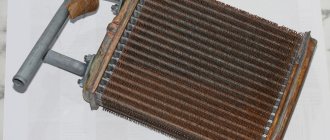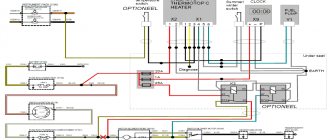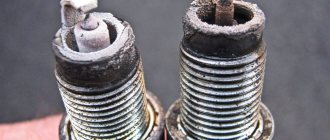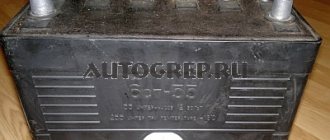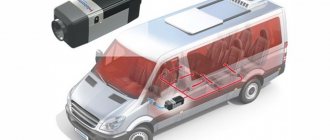If in winter you have to dance next to your car for half an hour, waiting for the interior to warm up at least a little, a compact heater will solve the problem. In our review you will find the best models of car hair dryers, as well as serious heating systems that can create comfortable conditions even in a very spacious interior of a minivan, SUV, passenger bus or motor home.
What is a cabin heater?
One of the main problems of operating a car in winter is difficulty starting the power unit. In cold weather, due to the high viscosity of the oil, the engine starts poorly and requires pre-heating. The standard heater cannot cope with this task, since it turns on only when the power unit is running.
It is also irrational to use engine-powered stoves during long periods of parking. To do this, you need to start the engine, which entails high fuel consumption: even at idle, the power unit of a cargo vehicle similar to KamAZ “eats” about 8 liters of fuel per hour. In this case, the constant operation of the piston group is also unjustified, which leads to its premature wear.
Another aspect of the problem is the environmental component. If the driver has to stop in the city or in a public parking lot, the noise of the running engine and exhaust fumes will cause a lot of dissatisfaction among others.
For Russian drivers, all these issues are most relevant, because in most regions the cold period occurs for more than 6 months a year. What can we say about the Far North, where during the times of the USSR and cheap “state” diesel fuel, diesel engines were practically not turned off in winter? Pre-heating installations, which, in particular, were installed on military equipment, helped to prevent such a barbaric attitude towards cars to some extent. However, they did not solve the problem of heating the cabin.
In warmer Western Europe, there were significantly fewer problems with winter operation of cars, but it was from there that the trend came to install autonomous heaters on cars. Germany has achieved particular success in this matter, where the law prohibited turning on the engine while parked. And even though it is customary for German truckers to spend the night in comfortable motels rather than in trucks, and winters are much milder, a few hours spent in a windy warehouse or customs office made us think about an alternative solution to the problem. This is how the idea of heating with an air dryer came about. In the USSR, similar devices were manufactured by the Shadrinsky Automotive Aggregate Plant and installed on Zaporozhets. However, they were extremely capricious, unreliable and often caused fires. For the most part, domestic drivers continued to use handicraft inventions such as transferring heat to the cabin via copper wire wound around the exhaust pipe. They learned about high-quality interior heaters only during the period of mass import of foreign cars, including minibuses, into the country. These devices operated autonomously in economical mode and provided heating for a long time.
Connection
According to preliminary data, each heater circuit will have a load of about 20 A. The first circuit allows you to connect the air heater not through the computer, but directly through a latching button and relay. The control wire to the relay can be taken from the fan. That is, to turn on the electric heater you will need to press a button and turn on the fan. Shutdown is controlled manually! It should be understood that when all three circuits are turned on, such an electric hair dryer will consume a large amount of current, which is not so much at idle, and even more so in cold weather. Therefore, adding intermediate power levels may be considered. If you use two buttons in the circuit, then the first will include 2 circuits, and the second will include a third. And if the control signal is taken from the glass heating, then there will be a shutdown timer.
Interior heater diagram
The design of autonomous heaters varies depending on the type and model. The general layout of the interior heater includes:
- combustion chamber;
- heat exchanger;
- fan;
- some models have a separate fuel tank;
- hoses for supplying air to the combustion chamber and removing exhaust gases.
The equipment set includes a fuel pipe, a fuel line pump, wires, and fasteners.
Table: technical characteristics of Webasto Air Top 2000 ST
| Permissible fuel supply height H (m) | 1-2 |
| Permissible fuel suction height S (m) | 1 |
| Maximum permissible excess pressure in the fuel line (bar) | 0,03-0,11 |
| Maximum permissible vacuum in the fuel tank (bar) | -0,02 |
| Voltage, V | 12 for petrol, 12/24 for diesel units |
| Fuel | petrol/diesel |
| Heating power, kW | 2 |
| Power consumption, W | 14 — 29 |
| Fuel consumption, l/hour | 0,14 — 0,27; 0,12 — 0,24 |
| Max. volume of supplied air, m3/h | 78 |
| Weight, kg | 2,6 |
| Dimensions, mm | 311 x 120 x 121 |
How does an auxiliary heater work?
It is very easy to understand how an air car heater works:
- Fuel enters the combustion chamber and is ignited.
- Cold air from the passenger compartment is forced by a fan into the flame tube area, where it is heated.
- The heated air masses return to the cabin.
- Combustion products are removed from the chamber through a heat-resistant sleeve.
Devices that additionally perform the function of engine preheating have a common circuit with the cooling system.
How to use an autonomous heater?
Before you start using your car's autonomous heater, you need to check its functionality. Diagnostics are performed automatically, and fault information is displayed as a code on the display, for example:
- 011 or 002 – low voltage;
- 012 – overheating.
It is not recommended to ignore these messages: in case of critical problems, the operation of the heater will be blocked.
If everything is normal, the fuel is ignited and the fan turns on. If smoke appears, you need to check the condition of the air intake; it may be covered with snow. In the worst case, smoke is caused by a broken control unit. The fan should operate without squeaks: extraneous noise is a sign of broken bearings.
The autonomous unit is capable of heating for a long time, but if the voltage drops, it will automatically turn off in order to maintain the ability to start the engine.
General recommendations include using only high-quality fuel, otherwise it may thicken and the device will refuse to work.
Every year, before the onset of cold weather, you need to perform a test run and check the condition of the air ducts and filter. It is better to do this ahead of time, so that if any malfunctions are detected, you have time to contact a car service center before there is a queue with similar problems.
Terms of use
If they are not followed, autonomous stoves will fail ahead of time in severe frosts and other unpredictable situations. To avoid costly repairs, you must turn on, operate and turn off the devices according to the instructions.
- Before initial start-up, perform diagnostics. Turn on the ignition only if there are no fault codes 002, 052 or 001 (as well as others) on the remote control.
- During operation, the heater may overheat. Then it will be automatically blocked. If the device does not have any malfunctions, the fan will turn on. It will purge the combustion chamber, freeing it from fuel vapors. Then you can start the stove again.
- Turning off the autonomous heater is also not so easy. First, the fuel pump stops, then the torch goes out, cleaning starts, and the heat exchanger cools.
- In winter, the intake air pipe may become clogged with snow dust. Because of this, the combustible mixture becomes over-enriched and a lot of smoke appears. As a rule, there is nothing dangerous about this. But if the fan constantly makes squeaks, you should urgently show the device to a specialist. This is a clear sign of bearing failure.
- The control unit located under the fan may fail. In this case, it will not produce the correct rotation speed, and again a lot of smoke will be produced. In the worst case, the unit will explode due to a short circuit. As a rule, this happens due to the fault of the driver himself. For example, when it does not turn off the “autonomy” while transferring current to another battery - “lighting up”.
And of course, when operating gas Webasts, it is important to prevent liquid gas from escaping. Also, you should not allow the heater to operate at the highest possible speed, as this will excessively heat the air in the cabin and may cause you to feel unwell.
Types of interior heaters
All modern interior heaters are classified by type into:
- air;
- liquid;
- gas;
- electric.
Interior air heater
The first representatives of autonomous interior heaters were air heaters with the operating principle of a conventional hair dryer. The air flow is passed through the heating element and supplied to the cabin by fans. In older models, the function of the heating element was performed by a metal spiral, then it began to be replaced with ceramics, which made it possible not to dry out the air and maintain normal humidity.
Interior liquid heater
The heaters are integrated into the overall car system: the power is connected to the standard fuel line, and the electrical components are connected to the car’s electrical circuit. When the device is turned on, the liquid in the cooling system is heated and passed through the engine and radiator. As the desired temperature is reached, the fan turns on and warm air enters the cabin. The device automatically reads readings from temperature sensors, regulates the pumping of refrigerant and the intensity of the fan.
The interior liquid heater can be started manually or automatically according to a precisely specified switching time. The remote control device included in some models allows you to issue commands from a distance of up to one kilometer.
Gas interior heater
The operating principle of gas interior heaters is similar to liquid models, with the difference that they are not connected to the vehicle’s fuel system. Propane is used as fuel, which is supplied by a separate reducer. Gas enters the chamber through a nozzle, which sprays it. Automation regulates pressure, injection force and temperature indicators.
In terms of efficiency, gas models are not inferior to liquid ones, and in some characteristics they are superior to them.
Electric interior heater
Heater models operating from a household AC power supply of 220 V cannot be classified as autonomous. It is convenient to use such devices for pre-heating the engine and heating the interior in parking lots equipped with sockets, however, if the stop occurs in an open field or just in the middle of the street, then an electric interior heater is of no use.
When it warms
Electric heaters are standard on many models of the 2000s and 2010s. For example, on diesel versions of Citroen, Peugeot, Skoda, and in Ford it is also used on gasoline versions. As a rule, cars for Scandinavian countries and northern markets in general are equipped with it. Sometimes heaters are installed but not activated (more on that later).
It is curious that not all owners are even aware that their car has such a heater. And those who know are not always sure that it works. There are also questions about exactly in what situations the electric heater turns on, and whether this requires any action on the part of the driver.
In fact, this function is purely automatic. If the heater is activated and working properly, it turns on itself if several conditions are met:
- air temperature not higher than +4..+10°С;
- coolant temperature not higher than +60..+80°С;
- The battery is sufficiently charged.
It is clear that temperature indicators depend on the parameters adopted by the manufacturer, assessment methods and critical parameters for the battery may also vary, but if the battery is weak, the heating may not turn on (the same applies to other functions, for example, the Start/Stop system) .
In general, the heater turns on automatically in cold weather and when the engine is cold. You can understand that it is working precisely by the fact that warm air begins to flow within one or two minutes, although the needle of the engine temperature indicator does not even move on the scale yet. On some models, when the heater is turned on, the idle speed of the engine becomes higher, a characteristic “drawdown” may be felt, as when powerful consumers are turned on (radiator fan, air conditioner), and relay clicks may also be heard when the system is turned on and off.
Types of interior heaters by power source
Depending on the type of fuel, auxiliary heaters are:
- electric for 12 and 24 V;
- gasoline;
- diesel;
- gas.
Interior heater 12 volts
These are compact, low-power mobile interior heaters (up to 200 W), powered by a 12 V car cigarette lighter. Their function is limited to heating the driver’s seat and windshield. Such devices can be quickly installed and removed by yourself.
Interior heater 24 volts
24 V interior air heaters are similar to previous devices, but are used primarily in trucks. Instead, you can use 12-volt models with a current converter.
Petrol interior heater
Unlike air heaters, gasoline heaters perform 2 functions at once: heating the interior plus pre-heating the engine. Gasoline models are more efficient than air models, but are more expensive and require complex installation.
Diesel interior heaters
Structurally, diesel interior heaters are identical to gasoline ones. Their power reaches 5 kW or more, and fuel consumption averages 0.4 liters per hour, which is 40 times less than when the engine is running.
Table: advantages and disadvantages of autonomous vehicles
| Advantages | Flaws |
| Autonomous mode, does not depend on external power sources. | Difficulty of installation. This is not an electric heater that you can easily install yourself. |
| Super-efficient and capable of long-term continuous operation. On cold winter days, the car interior and internal combustion engine can be heated to operating temperature with a fuel consumption of less than 1 l/h in just 40-50 minutes. | Expensive. Even basic models cost an order of magnitude higher, without additional components. In addition, the installation of such equipment is highly valued - at least 8-10 thousand rubles. And the more difficult it is to find a place under the hood for installation, the more expensive the installation will be. |
| Wide range of activation and programming options. | Some models are dependent on fuel quality. It is recommended to pay attention to this and regularly carry out diagnostics and cleaning. In addition, there is a dependence on the battery. You should always keep a charged and reliable battery under the hood. |
Types of interior heaters by vehicle type
When choosing a heater, it is important to correctly calculate the required power. Many PBX owners believe that the larger it is, the better. However, this opinion is wrong. Unreasonably high heater power will lead to excessive fuel consumption and premature wear of the equipment.
Air heater for passenger car interior
If you need to completely heat the passenger car interior, then it is enough to install a liquid model of an autonomous heater with a power of up to 2 kW. To heat one driver's seat, you can use a “dry hairdryer”.
Air heater for truck interior
The choice of an autonomous heater for a truck depends on the dimensions of the vehicle and the heated area. To heat the driver's seat, you can use an "air"; for a small cabin, a power of 2 kW is sufficient. If the cabin is high and equipped with a berth, then a heater of up to 4 kW will be required, and for heating the cargo compartment - 5 kW or more.
Heater for minibus interior
To heat the interior of a minibus with a passenger capacity of up to 12 seats, a 3 kW heater is sufficient. On larger machines, 4-4.5 kW equipment is installed.
Bus interior heater
For the bus interior you need to choose heaters with a power of 4.5-5 kW
Table: technical characteristics of Webasto Air Top 3500
| Heating power, kW | 3,5 |
| Rated voltage, V | 12/24 |
| Fuel | diesel |
| Fuel consumption, l/h | 0,42 |
| Power consumption, W | 36** |
| Supply volume air, m 3 / h | 138 |
| Heater dimensions, mm (length x width x height) | 425 x 148 x 148 |
| Weight, kg | 5,9 |
| Internal temperature control range | -40… +20 °C |
| Volumetric flow of heated air at fan speed, relative to 0.5 mbar | Max. 132 (200) m3/h at 3600 (5000) rpm |
| CO2 in flue gases (permissible operating range) | 1.5 kW: 5.0-8.0%; 3.5/5.0 kW: 9.0-12.5% |
Aero Comfort (2)
Webasto
Founded in 1901, the German company Webasto is a recognized leader in the field of climate control technology for vehicles. The Webasto line includes air, gasoline and diesel heaters with a power from 2 to 5.5 kW. The company's products are in great demand all over the world, including in Russia. In particular, Webasto equipment is installed on the racing cars of the KamAZ Master team.
Planar
Under the Planar brand, diesel heaters are produced by the Samara enterprise Advers. The product line consists of models with a power of 2-8 kW. With high quality, they are significantly lower than their foreign analogues. The products have international certification and are successfully sold abroad, including in the USA.
Aero comfort
Aero Comfort heaters are another Russian development that can compete in quality and price with foreign analogues. The products are manufactured by the TeploAvto enterprise from Naberezhnye Chelny. Available in 2 and 4 kW models.
Popular manufacturers of car heaters
Autonomous heaters (stoves) for cars are produced by many companies. But not all brands can boast of reliability. The best brands are listed below:
- Webasto . The German company is widely known for the quality of its products. It has been on the market for more than a century and traditionally surprises consumers with innovative technologies.
- Eberspacher . A small family brand from Germany, over more than 150 years of existence, has managed to grow into a serious brand with representative offices in different countries.
- Belief. A well-known company that produces various types of equipment. It is characterized by reliability and an innovative approach to product line development.
- Planar . The Russian brand, whose factories are located in Samara, produces affordable and high-quality products adapted to Russian realities.
Additional interior heater: pros and cons
While the car's standard heater is powered by the internal combustion engine, an additional heater provides heat to the vehicle's interior while parked with the engine turned off. Each type of auxiliary heater has its own advantages and disadvantages.
Dry air dryers
Pros:
- compact;
- do not consume gasoline (diesel);
- easy to install and remove.
Minuses:
- low-power;
- drain the battery;
- do not provide engine warm-up.
Liquid and gas
Pros:
- high power;
- possibility of remote control and automatic start at a specified time;
- engine pre-heating;
Minuses:
- emit combustion products, which is why they cannot be used in closed parking lots;
- require complex installation with connection to vehicle systems.
Electrical 220 V
Pros:
- have high power;
- do not consume the vehicle’s energy resources (battery charge and fuel);
- can be used in closed parking lots;
Minuses:
- take up a lot of space;
- require connection to a household electrical outlet.
To provide themselves with warmth under any circumstances, drivers often install 2 heaters of different types.
Equipment arrangement
A mobile additional stove for a car interior is a device in miniature representing the heating system of a car, however, with the introduction of certain changes. So, for the efficient operation of the heating system and general operability when installing such equipment, it is necessary to either install pipes and the connected housing in parallel into the heating system, or connect to the standard heating system inside the cabin.
Features of additional car interior heaters are:
- Autonomy of use of some models. Some products operate both from the vehicle’s on-board network and from a 220V inverter, which allows it to be powered both from a stationary network and from the car’s network. However, such products are highly expensive and in most situations their capabilities are quite redundant (except for cases of constant exposure to extremely low temperatures, where saving electricity is also vital);
- The heating area coverage of such devices is limited, as is the power generated . An additional stove will not be able to fully replace standard heating, since its size and power are incommensurate, but it is quite capable of significantly increasing the efficiency of the heating system;
- Installing the device does not present any particular difficulties for people who are at least somewhat familiar with the internal structure, so calls to a specialized service for assistance in installing the system are not constant;
In the video there is an additional heater in the car interior:
Installation of an autonomous heater
The equipment is located in the car interior or in the engine compartment. In the first case, it is necessary to remove the hoses for supplying air to the combustion chamber and exhaust gases to the outside, in the second, to ensure the supply of heated air inside. General algorithm for installing the interior heater:
- Selecting the location of the heater unit and fixing it.
- Connection to the fuel line (if power is not provided from your own tank).
- Connection to the fuel line.
- Installing the control unit on the dashboard.
- Integration of AO into the cooling circuit.
- Installation of air ducts.
How to start an autonomous heater?
Before installing and starting the autonomous heater, you need to make sure that its device characteristics correspond to the on-board parameters. Subsequent actions are carried out in accordance with the operating instructions. We recommend ordering the installation of the heater from a certified company, where they will make a professional selection of equipment for your vehicle.
Installing an autonomous heater in a car
The use of 220 V electric heaters or dry hair dryers does not require special installation. To operate, they simply connect to the power supply. The situation is different with liquid and gas models. They are integrated into the structure of the car and affect its important components: fuel line, cooling system, electrical circuit. Therefore, it is better to install such an autonomous heater on a car at a car service center. In this case, you are guaranteed to receive maximum productivity from the device and consultation with a specialist. However, with a sufficient level of preparation, you can complete the installation yourself.
Installing an autonomous heater on a truck
Installing an auxiliary heater on a truck is often done outside the cab under the hood of the vehicle. In this case, the hoses through which warm air enters are routed inside through existing or made holes.
Do-it-yourself installation of an autonomous heater in a car
If you have sufficient skills, you can install an autonomous liquid-type heater on a car yourself. In this case, you need to pay attention to the routing of wires and the fuel pipe. To avoid tears, bends and contact points with sharp edges of the body are reinforced with cuffs.
After installation is completed, it is necessary to check the tightness and reliability of fixation of all elements, conduct a test run, measuring the level of current consumption and heating temperature.
How to choose an autonomous heater for your car
The car market offers a large number of additional heaters of various configurations and prices. Car owners are always faced with the question of how to choose an autonomous heater for their car in order to get the most practical device at a reasonable cost. Much depends on how often you drive in winter, and how much time you spend in open parking lots or unheated garages. In addition, there are many other criteria:
- climate of the region;
- dimensions of the car and dimensions of the heated area;
- design features of the machine;
- the type of fuel the vehicle runs on;
- current-voltage characteristics of the on-board electrical circuit, etc.
We must not lose sight of such factors as the price of the device, taking into account the profitability of use and payback period. In this case, it is better to take equipment from well-known manufacturers with good reviews.
Autonomous air heaters: catalog and prices
- from 20,150 ₽
Aero Comfort 4d 12V
Buy in 1 click
More details
- from 20,150 ₽
Aero Comfort 4d 24V
Buy in 1 click
More details
- from 45,240 ₽
Webasto Air Top 2000 STC 12V
Buy in 1 click
More details
- from 62,000 ₽
Webasto Air Top Evo 40 (petrol) 12V
Buy in 1 click
More details
- from 91,700 ₽
Webasto Air Top Evo 55 12V
Buy in 1 click
More details
- on request
Planar 2D-S (2 kW) 24V
Buy in 1 click
More details
- on request
Planar 2DS (2 kW) 12V
Buy in 1 click
More details
- on request
Planar 44D-GP-S (4kW) 12V
Buy in 1 click
More details
- on request
Planar 44D-GP-S (4kW) 24V
Buy in 1 click
More details
- on request
Planar 4DM-S (3 kW) 12V
Buy in 1 click
More details
- on request
Planar 4DM-S (3 kW) 24V
Buy in 1 click
More details
- on request
Planar 8 DM-S (7.5 kW) 12V
Buy in 1 click
More details
- on request
Planar 8 DM-S (7.5 kW) 24V
Buy in 1 click
More details
- on request
Planar 9D (8 kW) 12V
Buy in 1 click
More details
- on request
Table: technical characteristics of HYDRONIC B4W SC
| Coolant | Water, coolant |
| Heat flow regulation | High, small |
| Heat Flux (W) | 4300/1500 |
| Fuel consumption (l/h) | 0,2-0,6 |
| Average electrical consumption power (W) in operating mode | 22-48 |
| Average electrical consumption power (W) at startup | 120 |
| Rated voltage | 12 V |
| Permissible operating pressure | up to 2.5 Atm |
| Amount of water in the heating device | 0.18 l |
| Water pump capacity at 0.1 atm | 900 l/h ±100 l/h |
| Minimum water throughput of the heating device | 250 l/h |
| Permissible ambient temperature in operating mode | -40 °C to +80 °C |
| Weight - without coolant and mounting parts | 2.7 kg |
